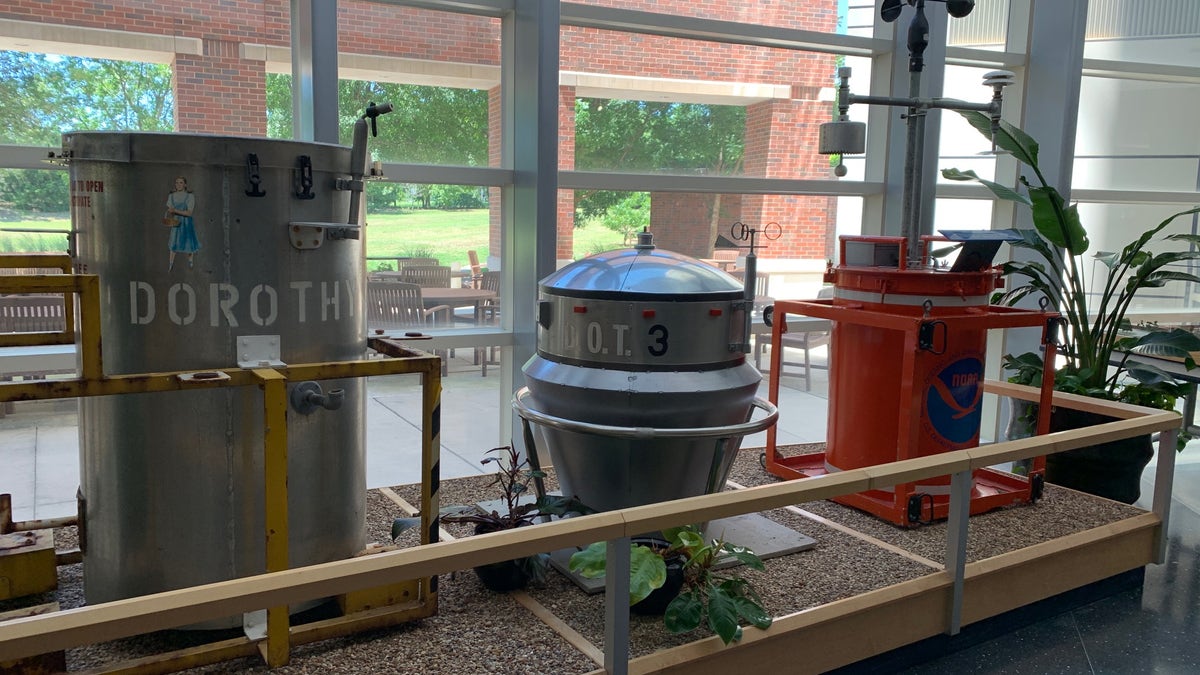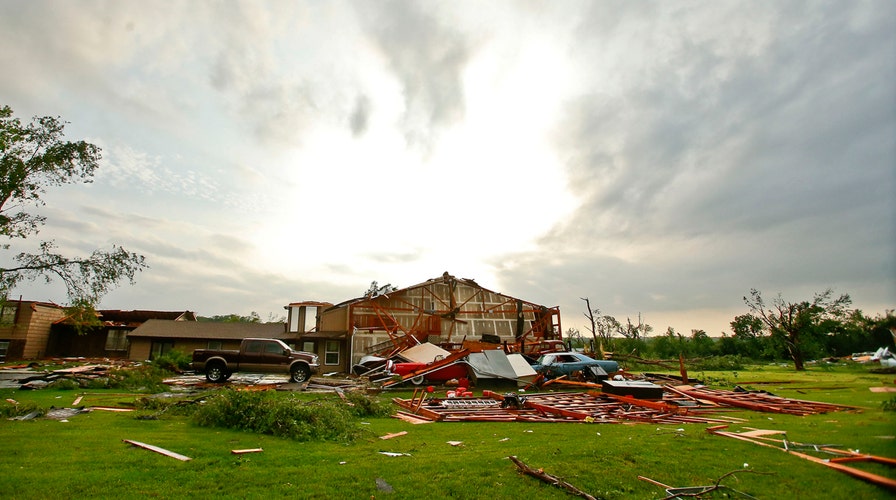Tornado, severe weather outbreak causing historic damage
A two-week onslaught of volatile weather has brought death and destruction from the Southern Plains to the Northeast, all because of a stalled weather pattern.
NORMAN, Okla. – It’s the kind of place that stays calm even when the world outside is alive with storms – or more specifically, tornadoes.
For the half dozen on-duty meteorologists – and just two or three on overnights – stationed at the NOAA/National Weather Service's Storm Prediction Center in Norman, south of Oklahoma City, the lives of all Americans are in their hands.
For the past two weeks in particular, several states across America’s heartland have been ripped up and open by the severe and deadly weather phenomenon, with millions caught in the crosshairs.
“Day after day we need to be on our game, there is no substitute for anything else. Here we have no media line, no distractions, its all about the science,” William Bunting, chief of forecast operations at the Storm Prediction Center told Fox News. “We stay focused on science and getting the job done, which is centered on saving lives. The decisions we make have the power to impact many, many lives across the country.”

William Bunting, Chief of Forecast Operations at the Storm Prediction Center in Norman, Okla. sits beside a hand-marked weather map (Fox News/Hollie McKay)
Indeed, the Center is quiet and bereft of external noise and chaos. Instead, the dedicated team of Ph.D. professionals – working behind glass walls and a blatant “Critical Severe Weather Day. Enter for Official Business Only” sign – intently study monitors and zone in on the mildest of changes in atmospheric pressure and cloud cover.
TORNADO SAFETY: HOW TO SURVIVE WHEN TWISTERS STRIKE
Five times a day, two of the team’s members publish an updated and detailed weather report, which is quickly disseminated globally.
“For severe weather, time is of the essence. The survivors are the ones who hear the warning and take action, they do what we want them to do,” Bunting explained. “That’s why they are alive. Given the (scope and number) of tornadoes in the past weeks, the death toll is relatively low. The system works and is doing what we hoped. We can make it better and that is why we all come to work every day.”
Still, tornadoes are being blamed for claiming the lives of 38 people just this year – with the vast majority of casualties stemming from an Alabama tornado in early March.
TORNADO, SEVERE WEATHER OUTBREAK MOST 'PROLONGED STRETCH' IN 8 YEARS -- AND HERE'S WHY
And while the team wholeheartedly embrace the advancements that have come with technological innovations in recent times, much of their methodology is steeped in the tried and trusted. Many of the team members still draw their maps and color-code them with pencils rather than relying on their state-of-the-art gizmos and gadgets. Green is for moisture, red is for temperature.
“The history of severe storm forecasting is closely tied to observational data. We tend to think differently drawing by hand then looking at a computer. If you look at data on a screen you might miss things,” Bunting cautioned. “By hand, I am forced to look at every little line I draw and analyze it. Some lines might not show up on a computer. So, we all have a box of pencils.”
Every pencil box is also storied in time and tradition. Most have been handed down by forecasters from generation to generation, and every meteorologist there will almost universally recount a childhood passion for understanding crazy weather.
“I was a late bloomer. I was nine when I got interested in the weather,” Bunting joked. “Most people here were already into it by the age of four or five.”
Below their second-floor offices, sit items from the 1996 epic “Twister,” starring Helen Hunt and Bill Paxton and executive produced by Steven Spielberg, and the staff’s “Flying Cow” café – a homage to the Oklahoma-set tornado flick.

Inside the Storm Prediction Center (Fox News/Hollie McKay)
But repeatedly, Bunting makes clear that they harbor no Hollywood fantasies over their duty to the American people – to be as right as possible as much of the time.
“We have been nonstop trying to get the message out to people, to highlight that while the storms they may have had yesterday, the worse was coming. We are constantly focused on how we can get the details of that message out to the people who need it,” Bunting noted. “Each day is different; each day is serious. And when the storms get close to us at Norman, we have to call our own families too.”

"Twister" items from the hit 1996 film set in Oklahoma
ARKANSAS RIVER COMMUNITIES COME TOGETHER TO DEAL WITH HISTORIC FLOODING
And while much has been debated and dissected pertaining to the role climate change has had in the recent spout of erratic and unprecedented tornadoes carving paths through much of the country, the experts say there simply isn’t enough reliable historical record to make such a definitive judgment.
“We just don’t know. You would need a tornado record, and ours only goes back to 1950. And in the scheme of things, even though it sometimes doesn’t seem that way, tornadoes still are a rare event, to begin with,” Bunting continued. “We hear about them more now than we used to because people know to look for them or have a smartphone to document them or tweet. We know of so many more occurring because of this. In the end, we still know little about the conditions of exactly how they form.”
As it stands, there are still no reliable computer models to actively predict a tornado. Bunting stressed that they still very much rely on human analysis and information gathering and model attempts to-date have been sub-par – but at 59, he is optimistic that a dependable model will become available in his lifetime.

(Fox News/Hollie McKay)
Next door, a different team of experts hover around screens in the quest to change such a notion. This team convenes as part of the “Hazardous Weather Testbed” to develop and experiment with weather models and computer data, with the goal that it will become precise enough to be incorporated into the existing arsenal of scientific tools.
“The models they test are not yet proven but are the ones that have promise,” Bunting said.
Moreover, in an adjacent room down the hallway, another team of around 20 are managing the daunting task of providing urgent warnings to communities in the pre-dawn of a tornado or severe storm strike.
“That’s the most important thing we do, and last week somewhere in the state of Oklahoma a tornado hit every day,” said Rick Smith, the warning coordination meteorologist at the Norman Forecast Office of the National Weather Service. “We’ve issued over 80 warnings since the beginning of May to cities and counties, urging them to take cover.”

An expert team inside the National Weather Center "experimenting" in real-time with promising models to increase weather predictability (Fox News/Hollie McKay)
Smith stressed that while much progress has been made when it comes to accurately anticipating the weather, it remains a “complicated” artform, sometimes with next to no time to raise red flags.
He pointed to the tornado that hit the small Oklahoma town of El Reno, 50 miles away, last weekend. “Look at what happened in El Reno on Saturday night. A tornado developed very quickly, in just four minutes, up to 160 miles an hour winds, it hit around 10.30pm, then it was gone,” he recalled. “It was so fast; it is hard to react and hard to warn for that. It’s a scary deal.”
The sudden and ferocious tornado left an El Reno mobile home park and motel in tatters, but it was business as usual almost straight away.

El Reno was hit with a sudden tornado last weekend (Fox News/Hollie McKay)
“What can you say,” one local female nearby the razed area said on Thursday afternoon, in a nod to resiliency. “We go on.”









































